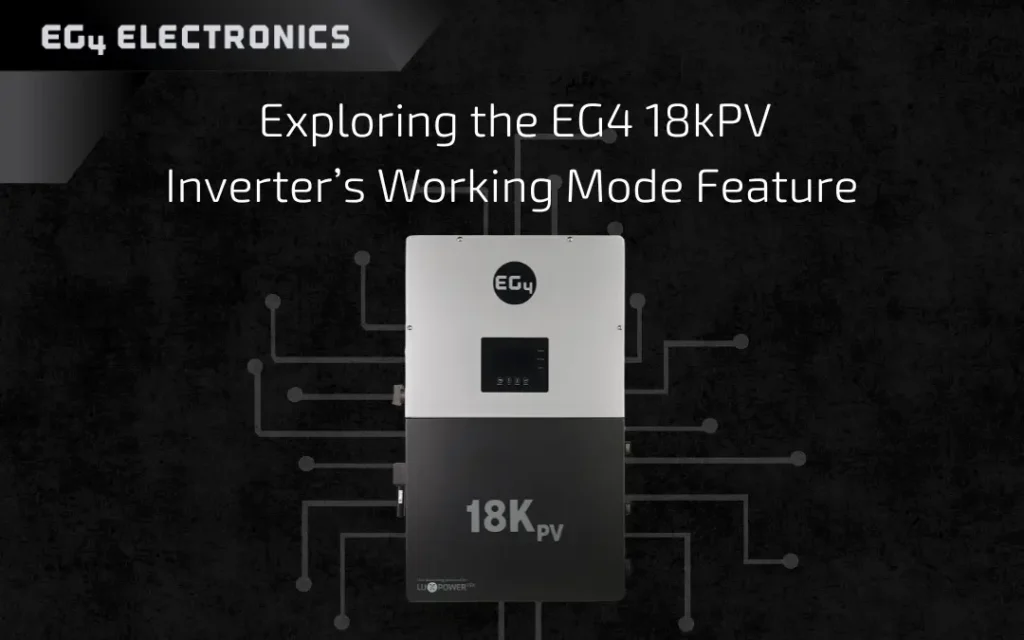If you’re an owner of the EG4 Electronics 18kPV-12LV All-In-One Hybrid Inverter, you might have stumbled upon the inverter’s working mode. This feature is a dynamic settings menu designed to elevate your experience to a whole new level of efficiency.
Picture this: a timeline that seamlessly integrates with your tasks, correlating settings with their precise functions. No more guesswork or trial-and-error approaches. Instead, you have a comprehensive overview of your options, allowing you to tailor your settings according to your specific needs and timeframes.
In this blog post, EG4 Electronics will delve into the intricacies of this innovative feature, exploring how it can streamline your workflow, boost productivity, and empower you to optimize your 18kPV experience like never before.
Configuring Working Modes in the EG4 Monitoring System
To activate and configure the different working modes for the EG4 18kPV Hybrid Inverter, users must log into the EG4 Monitoring System via a web browser. Below is a step-by-step guide to navigate to the working modes section within the monitoring system:
1. Login to the EG4 monitor center
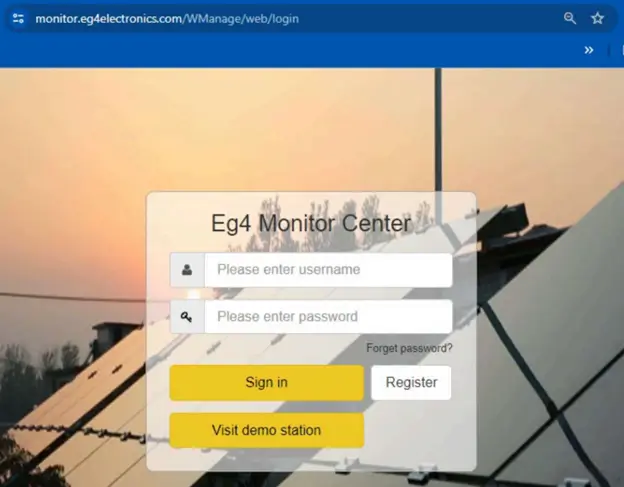
2. Select the station to be configured

3. Select “Read”

4. Navigate to the “Maintenance” tab

5. Select “Working Mode” in the top-right corner

6. Scroll down past “Application Setting” and find the “Working Mode Setting” section.
The user will now have direct access to configure the system to their own needs by utilizing a combination of settings and time of use periods. The remainder of this blog will describe the different modes of operation and descriptions of each setting associated with each mode.
Peak Shaving Mode
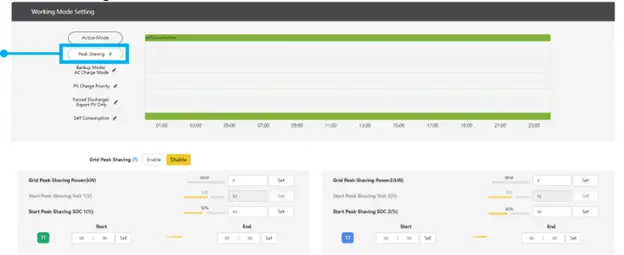
In essence, peak shaving is a feature designed to tackle those pesky spikes in your 18kPV’s energy demand that often accompany daily operations. Imagine a scenario where your facility is running multiple appliances, drawing a total of 9kW of power from the grid. However, you’ve set your “shaving power” threshold to 6kW. In this scenario, instead of solely relying on the grid for the entire 9kW, the peak shaving feature kicks in, offsetting the excess 3kW by drawing power from your inverter. This not only reduces your reliance on the grid but also helps in optimizing your energy usage.
Enabling peak shaving is a straightforward process. Simply toggle the setting to “enable” and set up your preferred timeframes. These timeframes allow you to specify when peak shaving should be active, along with the respective shaving power and minimum battery charge required to initiate the cycle. This level of customization ensures that Peak Shaving operates according to your specific needs and priorities.
It’s worth noting that peak shaving timelines hold precedence on the list of settings, provided their conditions are met. This means that even if other settings are in place, peak shaving will take priority, ensuring optimal energy management at all times.
Backup/AC Charge Mode
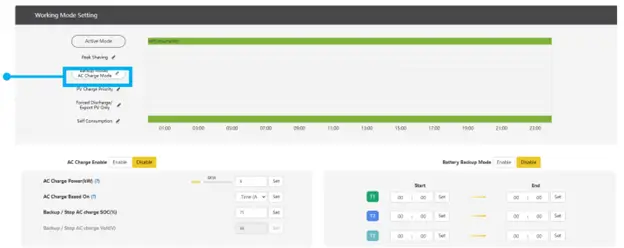
Designed to provide you with maximum control over your energy storage and consumption, backup/AC charge mode offers a range of functionalities aimed at optimizing your battery bank’s performance.
Backup/AC charge mode allows you to dictate when the grid should charge your battery bank, offering the flexibility to capitalize on off-peak energy costs. This strategic pairing with peak shaving enables you to not only minimize energy consumption during peak hours but also capitalize on lower electricity rates when charging your batteries.
Moreover, backup/AC charge mode goes a step further by incorporating a battery backup enable feature. This functionality empowers you to manually set your inverter to maintain optimal battery levels, akin to the start battery backup function accessible from the main monitor screen. This additional layer of control ensures that your battery bank remains topped off, ready to provide backup power whenever the need arises.
Additionally, backup/AC charge mode features three customizable timeframes and a maximum charge value at your disposal. This level of granularity allows you to tailor the mode according to your unique requirements and energy consumption patterns, ensuring seamless integration into your daily operations.
PV Charge Priority Mode

Harnessing the full potential of your photovoltaic (PV) system is paramount. Enter PV Charge Priority, a feature within the EG4 18kPV inverter that prioritizes power generation in the charging hierarchy.
PV charge priority simplifies the process of optimizing your PV system for battery charging. With straightforward settings, you can ensure that your PV output is primarily dedicated to charging your battery bank, maximizing the utilization of solar energy for storage purposes.
Even if your PV input exceeds the designated charge power variable, the excess energy won’t go to waste. Instead, it will seamlessly divert to powering your loads or, if export is enabled, feeding back into the grid. This means that even with a maximum battery charge power of 12kW, you have the potential to utilize up to 6kW of additional solar power to offset your loads. By prioritizing battery charging while intelligently managing surplus solar power, you not only optimize self-consumption but also minimize reliance on external energy sources.
Forced Discharge and Export PV Mode
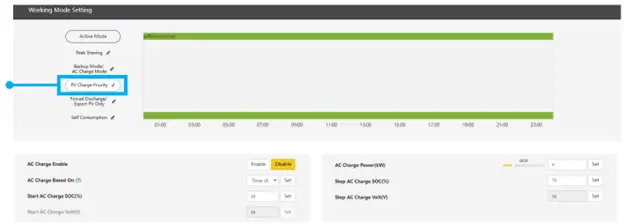
As we navigate the intricate landscape of energy management, it’s essential to have tools that cater to diverse needs and scenarios. Enter forced discharge and export PV only modes, two lesser known yet invaluable features within the 18kPV inverter that offer unique capabilities for optimizing energy utilization.
Forced discharge may not be the most common use case, but its potential implications are significant. This mode allows for the intentional cycling of batteries, even when it’s not the typical charging or discharging time. While it may have a lower priority compared to other modes, such as PV charge priority or backup/AC Charge Mode, its utility shines in scenarios where consistent battery cycling is beneficial. This consistent cycling can potentially lead to a net positive for exporting energy, particularly in time-based net metering arrangements. Thus, Forced Discharge emerges as a strategic tool for fine-tuning energy storage strategies and maximizing the benefits of battery systems.
On the other hand, Export PV Only mode offers a more straightforward yet equally valuable functionality. In situations where charging the battery isn’t necessary or desired, this mode directs the PV output directly to the inverter’s output, bypassing the battery altogether. While rare, this feature provides a convenient option for scenarios where maximizing immediate energy output takes precedence over battery storage. It’s a quality-of-life feature that adds flexibility and convenience to your energy management toolkit.
How the 18kPV Inverter Adapts to Your Needs
The introduction of the18kPV’s working mode marks a significant step towards simplifying energy storage systems. It’s important to note that when all other modes are inactive or disabled, the default operation of the inverter is geared towards self-consumption. This means that your system will intelligently utilize PV and stored battery power to power your loads, with any excess being reserved or used for charging. It’s a seamless and efficient approach that ensures maximum utilization of available resources while maintaining flexibility and reliability.
For more information about the working mode, take a look at EG4’s white paper on the topic. As we continue to innovate and evolve, your feedback remains invaluable. Whether you have suggestions, questions, or experiences to share, we encourage you to leave a comment on our social media pages.

